Removal of 2,4-Dichlorophenoxyacetic Acid from Aqueous Solutions Using Al2O3/Graphene Oxide Granules Prepared by Spray-Drying Method
Abstract
:1. Introduction
2. Materials and Methods
2.1. Materials
2.2. Adsorbent Preparation
2.3. Characterization of Adsorbent
2.4. Adsorption
3. Results and Discussion
3.1. Characterization of the Adsorbent
3.2. Adsorption Studies
3.2.1. Effect of pH
3.2.2. Adsorption Kinetics
3.2.3. Adsorption Isotherms
4. Conclusions
Author Contributions
Funding
Data Availability Statement
Acknowledgments
Conflicts of Interest
References
- Magnoli, K.; Carranza, C.S.; Aluffi, M.E.; Magnoli, C.E.; Barberis, C.L. Herbicides based on 2,4-D: Its behavior in agricultural environments and microbial biodegradation aspects. A review. Environ. Sci. Pollut. Res. 2020, 27, 38501–38512. [Google Scholar] [CrossRef]
- Loomis, D.; Guyton, K.; Grosse, Y.; Ghissasi, F.E.; Bouvard, V.; Benbrahim-Tallaa, L.; Guha, N.; Mattock, H.; Straif, K. Carcinogenicity of lindane, DDT, and 2,4-dichlorophenoxyacetic acid. Lancet Oncol. 2015, 16, 891–892. [Google Scholar] [CrossRef] [PubMed]
- Silva, A.P.; Morais, E.R.; Oliveira, E.C.; Ghisi, N.C. Does exposure to environmental 2,4-dichlorophenoxyacetic acid concentrations increase mortality rate in animals? A meta-analytic review. Environ. Pollut. 2022, 303, 119179. [Google Scholar] [CrossRef] [PubMed]
- Kim, S.J.; Gobi, K.V.; Tanaka, H.; Shoyama, Y.; Miura, N. A simple and versatile self-assembled monolayer based surface plasmon resonance immunosensor for highly sensitive detection of 2,4-D from natural water resources. Sensors Actuat. B Chem. 2008, 130, 281–289. [Google Scholar] [CrossRef]
- Gholamnia, R.; Abtahi, M.; Saeedi, R.; Khaloo, S.S. Synthesis and characterization of a new magnetic adsorbent for removal of 4-nitrophenol: Application of response surface methodology. Water Sci Technol. 2019, 80, 1430–1442. [Google Scholar] [CrossRef] [PubMed]
- Vedenyapina, M.D.; Kurmysheva, A.Y.; Kryazhev, Y.G.; Ershova, V.A. Magnetic Iron-Containing Carbon Materials as Sorbents for the Removal of Pollutants from Aquatic Media (A Review). Solid Fuel Chem. 2021, 55, 285–305. [Google Scholar] [CrossRef]
- Kumari, V.; Singh, P.P.; Kaushal, S. Synthesis and applications of metal-organic frameworks and graphene-based composites: A review. Polyhedron 2022, 214, 115645. [Google Scholar] [CrossRef]
- Şahin, S.; Emik, S. Fast and highly efficient removal of 2,4-D using amino-functionalized poly (glycidyl methacrylate) adsorbent: Optimization, equilibrium, kinetic and thermodynamic studies. J. Molec. Liq. 2018, 260, 195–202. [Google Scholar] [CrossRef]
- Kurmysheva, A.Y.; Yanushevich, O.; Krikheli, N.; Kramar, O.; Vedenyapina, M.D.; Podrabinnik, P.; Solís Pinargote, N.W.; Smirnov, A.; Kuznetsova, E.; Malyavin, V.V.; et al. Adsorption Ability of Graphene Aerogel and Reduced Graphene Aerogel toward 2,4-D, Herbicide and Salicylic Acid. Gels 2023, 9, 680. [Google Scholar] [CrossRef]
- Won, D.S.; Park, I.-S.; Park, M.; Sohn, Y.; Kim, B.-G.; Nahm, K.S.; Chung, K.-S.; Kim, P. Graphene oxide templated alumina nanosheet for the removal of As(V). Curr. Appl. Phys. 2014, 14, 1245–1250. [Google Scholar] [CrossRef]
- Abyzov, A.M. Aluminum Oxide and Alumina Ceramics (review). Part 1. Properties of Al2O3 and Commercial Production of Dispersed Al2O3. Refract. Ind. Ceram. 2019, 60, 24–32. [Google Scholar] [CrossRef]
- Grigoriev, S.N.; Trusova, E.A.; Afzal, A.M.; Soe, T.N.; Kurmysheva, A.Y.; Kuznetsova, E.; Smirnov, A.; Solís Pinargote, N.W. Peculiarities of γ-Al2O3 Crystallization on the Surface of h-BN Particles. Materials 2022, 15, 8054. [Google Scholar] [CrossRef] [PubMed]
- Kurmysheva, A.Y.; Vedenyapina, M.D.; Kulaishin, S.A.; Podrabinnik, P.; Pinargote, N.W.S.; Smirnov, A.; Metel, A.S.; Bartolomé, J.F.; Grigoriev, S.N. Adsorption Removal of Mo(VI) from an Aqueous Solution by Alumina with the Subsequent Regeneration of the Adsorbent. Int. J. Mol. Sci. 2023, 24, 8700. [Google Scholar] [CrossRef] [PubMed]
- Jacukowicz-Sobala, I.; Ociński, D.; Kociołek-Balawejder, E. Iron and aluminium oxides containing industrial wastes as adsorbents of heavy metals: Application possibilities and limitations. Waste Manag. Res. 2015, 33, 612–629. [Google Scholar] [CrossRef]
- Zotov, R.; Meshcheryakov, E.; Livanova, A.; Minakova, T.; Magaev, O.; Isupova, L.; Kurzina, I. Influence of the Composition, Structure, and Physical and Chemical Properties of Aluminium-Oxide-Based Sorbents on Water Adsorption Ability. Materials 2018, 11, 132. [Google Scholar] [CrossRef]
- Liu, L.; Zhang, B.; Zhang, Y.; He, Y.; Huang, L.; Tan, S.; Cai, X. Simultaneous Removal of Cationic and Anionic Dyes from Environmental Water Using Montmorillonite-Pillared Graphene Oxide. J. Chem. Eng. Data 2015, 60, 1270–1278. [Google Scholar] [CrossRef]
- Shen, Y.; Fang, Q.; Chen, B. Environmental Applications of Three-Dimensional Graphene-Based Macrostructures: Adsorption, Transformation, and Detection. Environ. Sci. Technol. 2015, 49, 67–84. [Google Scholar] [CrossRef]
- Czech, B.; Nasri-Nasrabadi, B.; Krzyszczak, A.; Sadok, I.; Hojamberdiev, M.; Yadav, R.; Shirvanimoghaddam, K.; Naebe, M. Enhanced PFAS adsorption with N-doped porous carbon beads from oil-sand asphaltene. J. Water Process Eng. 2023, 54, 104058. [Google Scholar] [CrossRef]
- Grigoriev, S.N.; Soe, T.N.; Malakhinsky, A.; Makhadilov, I.; Romanov, V.; Kuznetsova, E.; Smirnov, A.; Podrabinnik, P.; Khmyrov, R.; Solís Pinargote, N.W.; et al. Granulation of Silicon Nitride Powders by Spray Drying: A Review. Materials 2022, 15, 4999. [Google Scholar] [CrossRef]
- Li, Y.; Liu, J.; Deng, J.; He, J.; Qin, Y.; Xing, Y.; Yin, F. Fabrication of graphene oxide reinforced plasma sprayed Al2O3 coatings. Ceram. Int. 2023, 49, 1667–1677. [Google Scholar] [CrossRef]
- Kuśmierek, K.; Szala, M.; Świątkowski, A. Adsorption of 2,4-dichlorophenol and 2,4-dichlorophenoxyacetic acid from aqueous solutions on carbonaceous materials obtained by combustion synthesis. J. Taiwan Inst. Chem. Eng. 2016, 63, 371–378. [Google Scholar] [CrossRef]
- Vryonis, O.; Andritsch, T.; Vaughan, A.S.; Lewin, P.L. An alternative synthesis route to graphene oxide: Influence of surface chemistry on charge transport in epoxy-based composites. J. Mater. Sci. 2019, 54, 8302–8318. [Google Scholar] [CrossRef]
- Sharma, N.; Sharma, V.; Jain, Y.; Kumari, M.; Gupta, R.; Sharma, S.K.; Sachdev, K. Synthesis and Characterization of Graphene Oxide (GO) and Reduced Graphene Oxide (rGO) for Gas Sensing Application. Macromol. Symp. 2017, 376, 1–5. [Google Scholar] [CrossRef]
- Grigoriev, S.; Smirnov, A.; Pinargote, N.W.S.; Yanushevich, O.; Kriheli, N.; Kramar, O.; Pristinskiy, Y.; Peretyagin, P. Evaluation of Mechanical and Electrical Performance of Aging Resistance ZTA Composites Reinforced with Graphene Oxide Consolidated by SPS. Materials 2022, 15, 2419. [Google Scholar] [CrossRef] [PubMed]
- Santhiya, D.; Subramanian, S.; Natarajan, K.A.; Malghan, S.G. Surface chemical studies on alumina suspensions using ammonium poly(methacrylate). Coll. Surf. A: Physicochem. Eng. Asp. 2000, 164, 143–154. [Google Scholar] [CrossRef]
- Tucureanu, V.; Matei, A.; Avram, A.M. FTIR Spectroscopy for Carbon Family Study. Crit. Rev. Anal. Chem. 2016, 46, 502–520. [Google Scholar] [CrossRef] [PubMed]
- Lagergren, S. About the theory of so-called adsorption of soluble substances. Sven. Vetenskapsakad. Handingarl 1898, 24, 1–39. [Google Scholar]
- Ho, Y.S.; McKay, G. Pseudo-second order model for sorption processes. Proc. Biochem. 1999, 34, 451–465. [Google Scholar] [CrossRef]
- Zeldowitsch, J. The catalytic oxidation of carbon monoxide on manganese dioxide. Acta Physicochim. URSS 1934, 1, 364–449. [Google Scholar]
- Vieira, T.; Becegato, V.A.; Paulino, A.T. Equilibrium Isotherms, Kinetics, and Thermodynamics of the Adsorption of 2,4-Dichlorophenoxyacetic Acid to Chitosan-Based Hydrogels. Water Air Soil Pollut. 2021, 232, 60. [Google Scholar] [CrossRef]
- Gupta, S.S.; Bhattacharyya, K.G. Kinetics of adsorption of metal ions on inorganic materials: A review. Adv. Colloid Interf. Sci. 2011, 162, 39–58. [Google Scholar] [CrossRef]
- Langmuir, I. The constitution and fundamental properties of solids and liquids. PART I. SOLIDS. J. Franklin. Inst. 1916, 184, 102–105. [Google Scholar] [CrossRef]
- Gamal, R.; Rizk, S.E.; El-Hefny, N.E. The adsorptive removal of Mo(VI) from aqueous solution by a synthetic magnetic chromium ferrite nanocomposite using a nonionic surfactant. J. Alloys Comp. 2021, 853, 157039. [Google Scholar] [CrossRef]
- Srivastava, V.; Sharma, Y.C.; Sillanpää, M. Application of nano-magnesso ferrite (n-MgFe2O4) for the removal of Co2+ ions from synthetic wastewater: Kinetic, equilibrium and thermodynamic studies. Appl. Surf. Sci. 2015, 338, 42–54. [Google Scholar] [CrossRef]
- Boumaraf, R.; Khettaf, S.; Benmahdi, F.; Masmoudi, R.; Ferhati, A. Removal of 2,4-dichlorophenoxyacetic acid from aqueous solutions by nanofiltration and activated carbon. Biomass Conv. Bioref. 2022. [Google Scholar] [CrossRef]
- Calisto, J.S.; Pacheco, I.S.; Freitas, L.L.; Santana, L.K.; Fagundes, W.S.; Amaral, F.A.; Canobre, S.C. Adsorption kinetic and thermodynamic studies of the 2,4-dichlorophenoxyacetate (2,4-D) by the [Co–Al–Cl] layered double hydroxide. Heliyon 2019, 5, e02553. [Google Scholar] [CrossRef] [PubMed]
- Li, Q.; Su, H.; Yang, Y.; Zhang, J.; Xia, C.; Guo, Z. Adsorption property and mechanism of glutaraldehyde-crosslinked chitosan for removal of 2,4-dichlorophenoxyacetic acid from water. Environ. Sci. Water Res. Technol. 2023, 9, 294–307. [Google Scholar] [CrossRef]
- Kuśmierek, K.; Świątkowski, A.; Skrzypczyńska, K.; Dąbek, L. Adsorptive and Electrochemical Properties of Carbon Nanotubes, Activated Carbon, and Graphene Oxide with Relatively Similar Specific Surface Area. Materials 2021, 14, 496. [Google Scholar] [CrossRef]
- Kani, A.N.; Dovi, E.; Aryee, A.A.; Han, R.; Qu, L. Efficient removal of 2, 4-D from solution using a novel antibacterial adsorbent based on tiger nut residues: Adsorption and antibacterial study. Environ. Sci. Pollut. Res. 2022, 29, 64177–64191. [Google Scholar] [CrossRef]
- Manzotti, F.; Santos, O.A.A. Evaluation of removal and adsorption of different herbicides on commercial organophilic clay. Chem. Eng. Commun. 2019, 206, 1515–1532. [Google Scholar] [CrossRef]
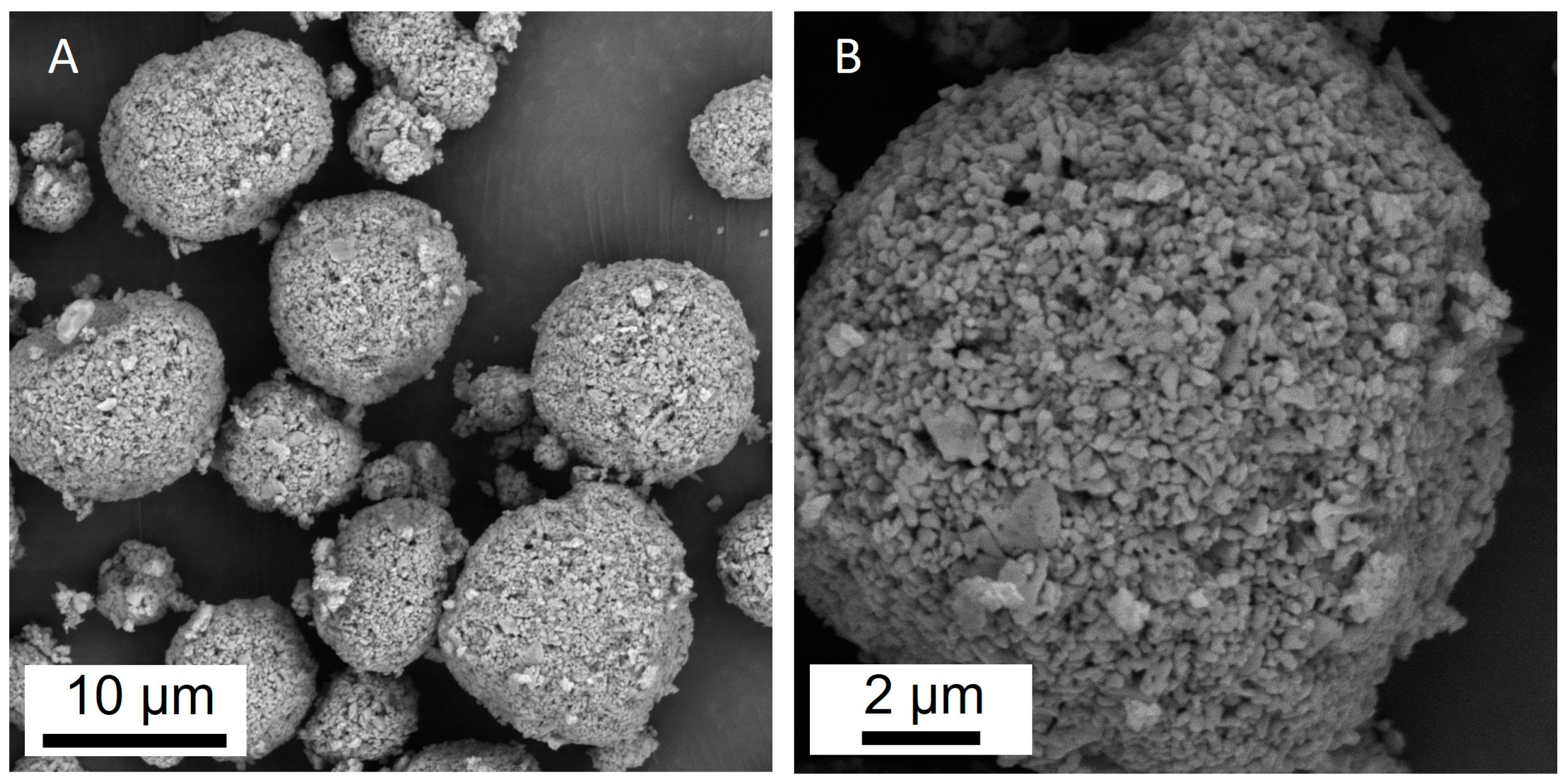
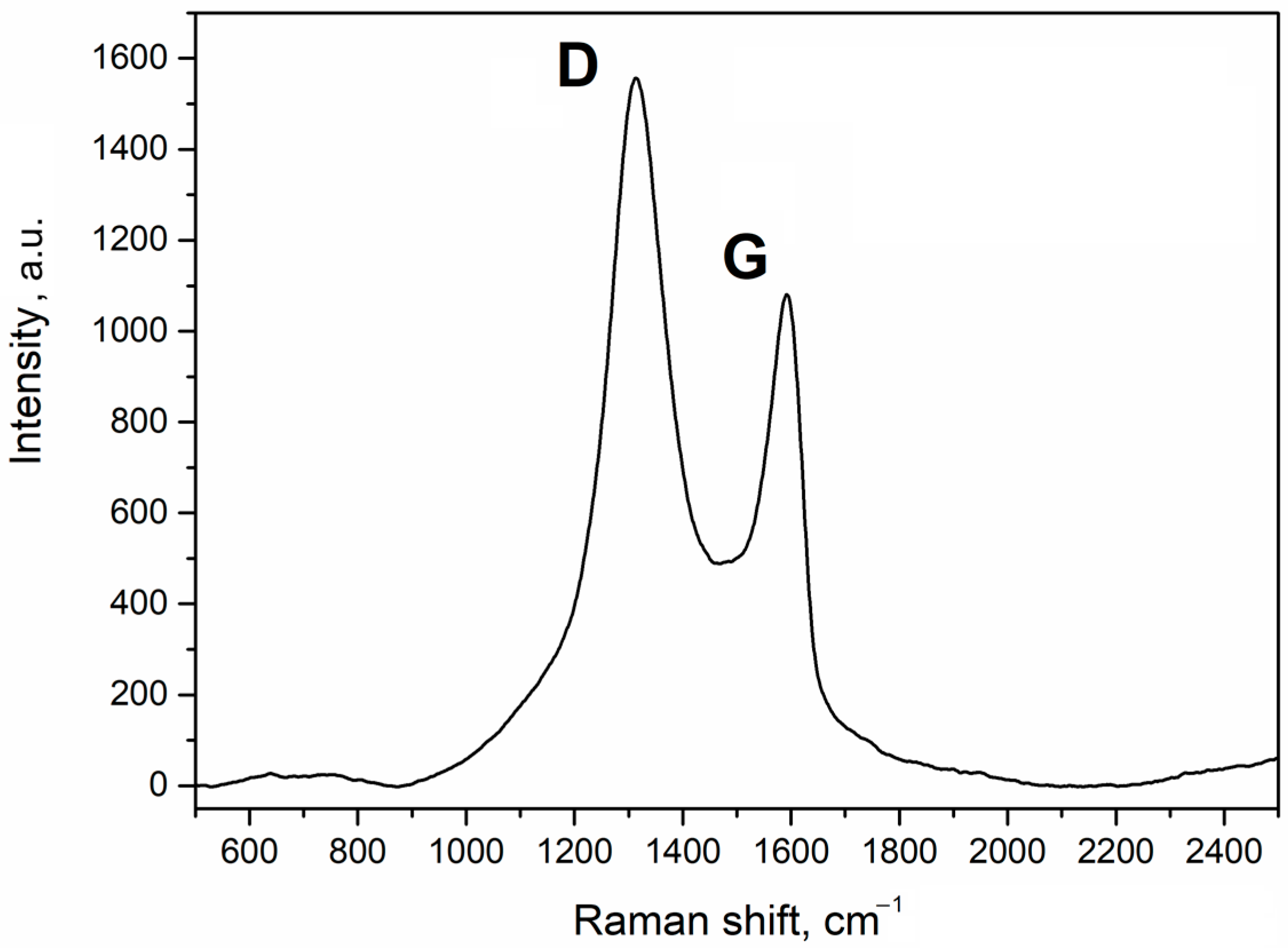
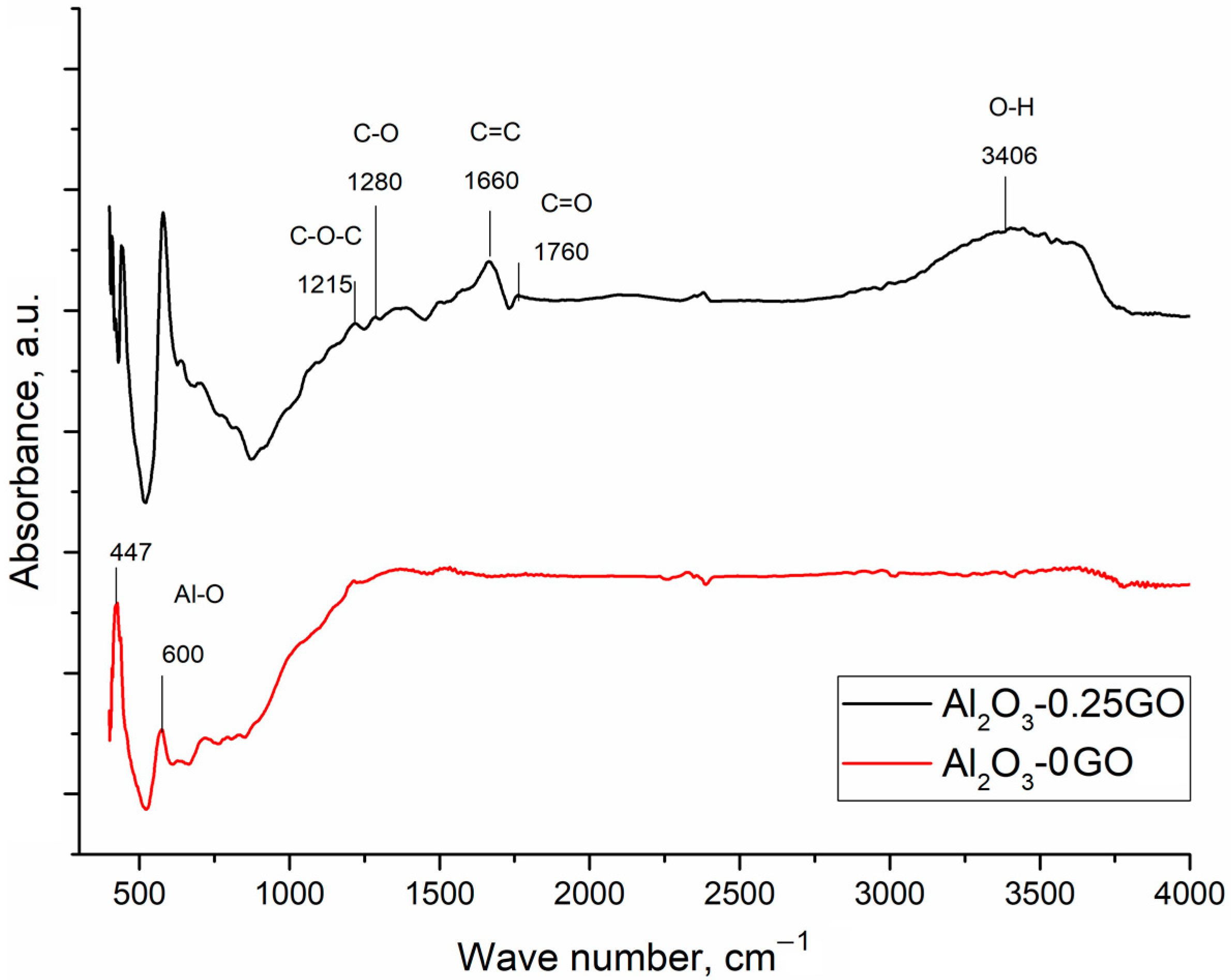
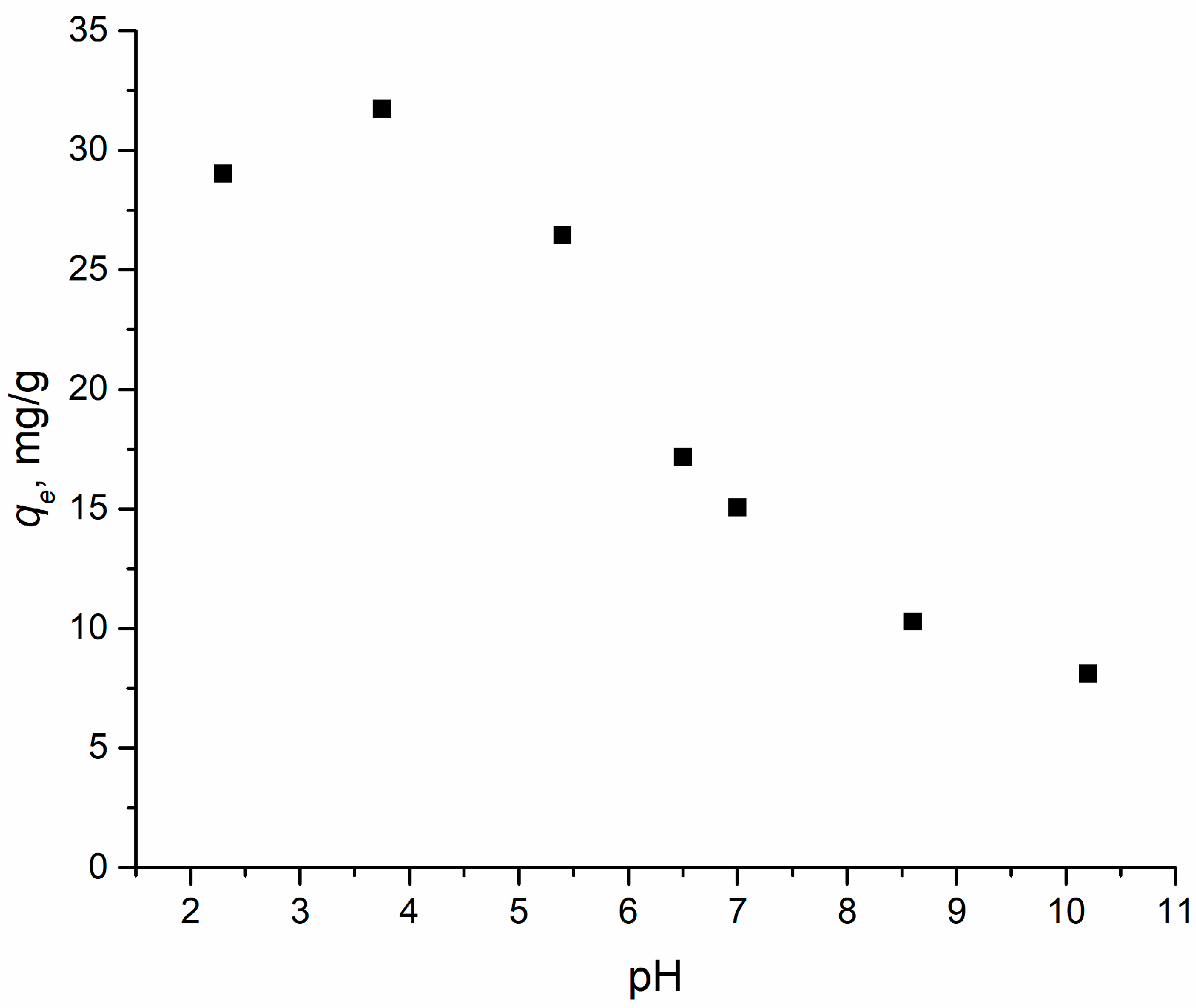
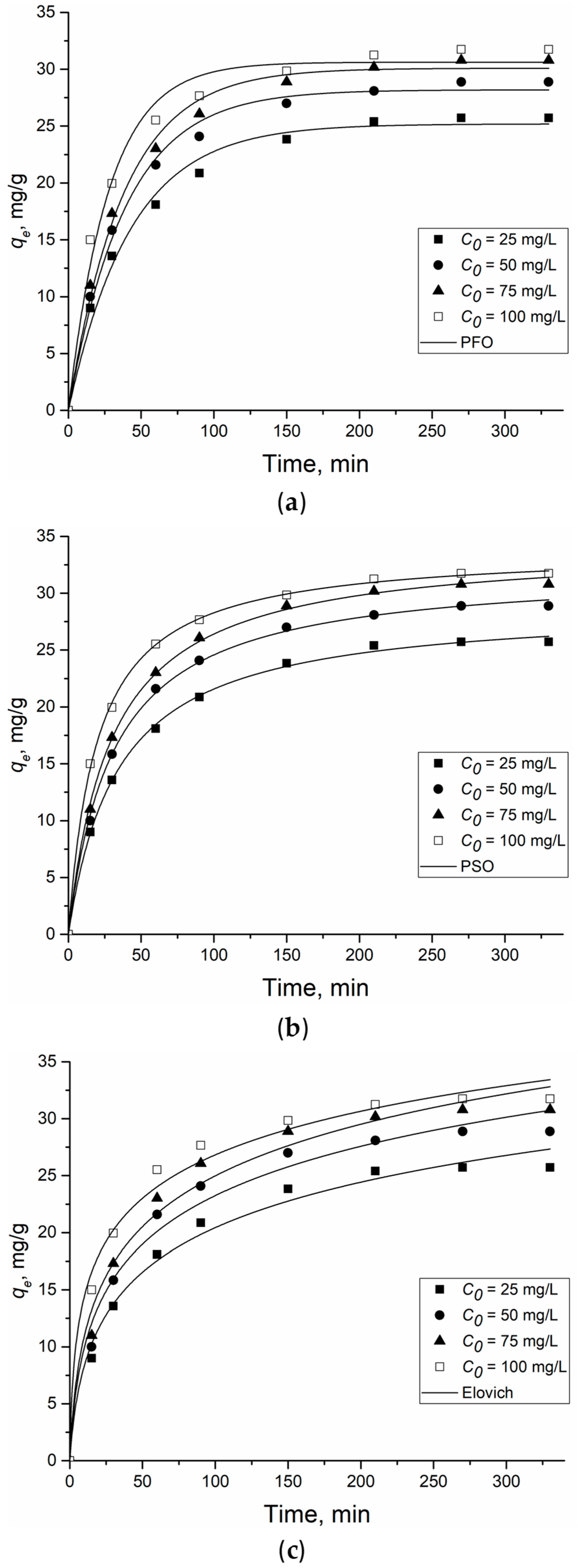
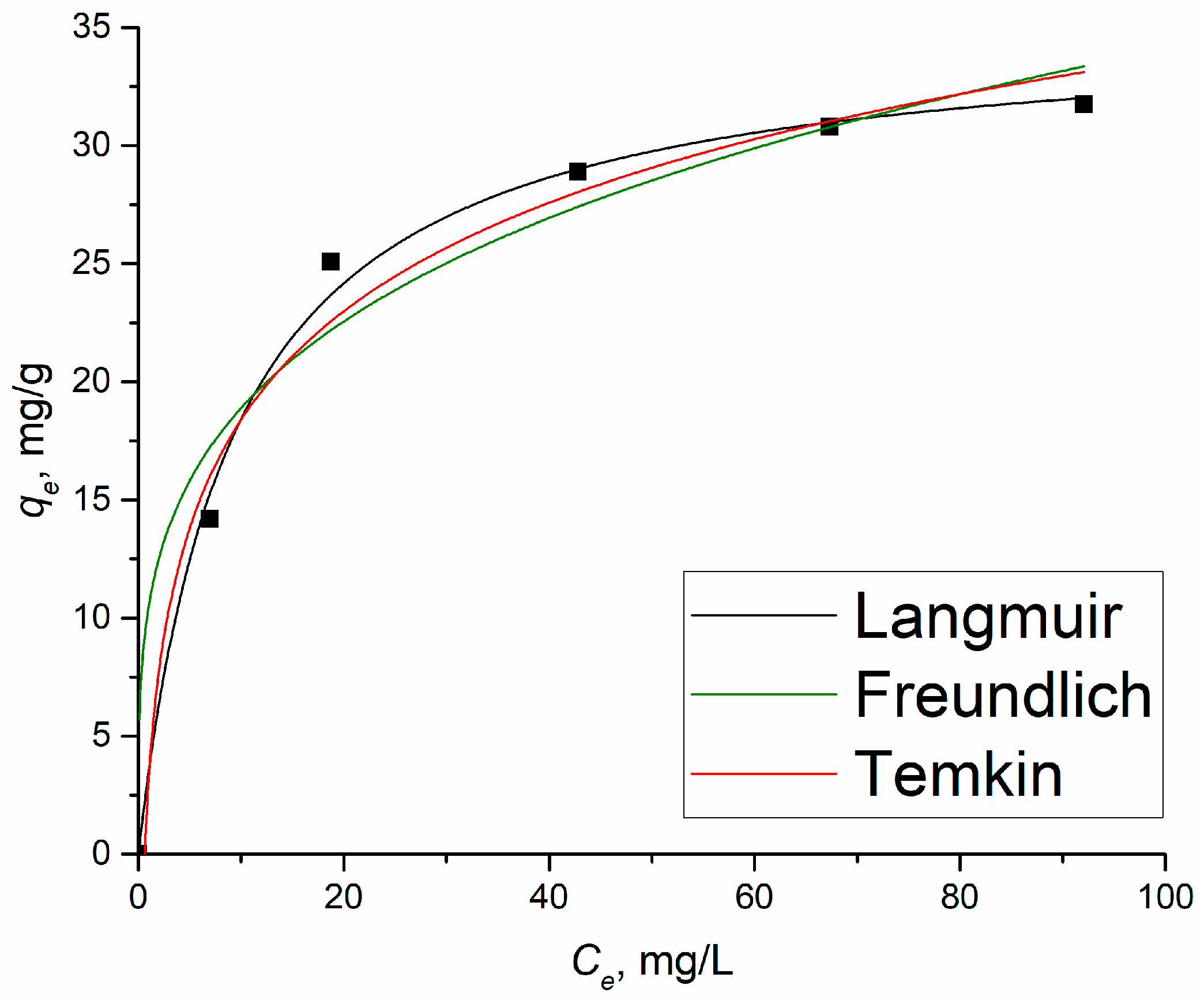
| C0, mg/L | Pseudo-First-Order | Pseudo-Second-Order | Elovich | ||||||
|---|---|---|---|---|---|---|---|---|---|
| k1 | qe1, mg/g | R2 | k2 | qe2, mg/g | R2 | α, mg/(g⋅min) | β, g/mg | R2 | |
| 25 | 0.023 | 25.19 | 0.989 | 0.001 | 28.914 | 0.998 | 1.84 | 0.15 | 0.988 |
| 50 | 0.026 | 28.189 | 0.993 | 0.001 | 32.173 | 0.999 | 2.393 | 0.15 | 0.982 |
| 75 | 0.027 | 30.092 | 0.993 | 0.001 | 34.21 | 0.999 | 2.787 | 0.15 | 0.982 |
| 100 | 0.036 | 30.622 | 0.984 | 0.002 | 33.888 | 0.999 | 6.89 | 0.18 | 0.988 |
| Model Parameters | Calculated Values | |
|---|---|---|
| Langmuir | qm, mg/g | 35.181 |
| bl, L/g | 0.109 | |
| R2 | 0.996 | |
| Freundlich | KF, L/g | 10.467 |
| 1/n | 0.256 | |
| R2 | 0.891 | |
| Temkin | bT, J/mol | 373.848 |
| A, L/g | 1.601 | |
| R2 | 0.984 | |
| Adsorbent | qe, mg/g | Equilibrium Time, Min | Ref. |
|---|---|---|---|
| [Co–Al–Cl] layered double hydroxide | 20.51 | 60 | [36] |
| Glutaraldehyde-crosslinked chitosan | 252.55 | - | [37] |
| Reduced graphene oxide | 270.1 | 1440 | [38] |
| Modified tiger-nut residue | 90.2 | 120 | [39] |
| Organophilic clay | 6.45 | 6 | [40] |
| Al2O3-0.25GO | 35.18 | 250 | This work |
Disclaimer/Publisher’s Note: The statements, opinions and data contained in all publications are solely those of the individual author(s) and contributor(s) and not of MDPI and/or the editor(s). MDPI and/or the editor(s) disclaim responsibility for any injury to people or property resulting from any ideas, methods, instructions or products referred to in the content. |
© 2024 by the authors. Licensee MDPI, Basel, Switzerland. This article is an open access article distributed under the terms and conditions of the Creative Commons Attribution (CC BY) license (https://creativecommons.org/licenses/by/4.0/).
Share and Cite
Kurmysheva, A.Y.; Kuznetsova, E.; Vedenyapina, M.D.; Podrabinnik, P.; Pinargote, N.W.S.; Smirnov, A.; Grigoriev, S.N. Removal of 2,4-Dichlorophenoxyacetic Acid from Aqueous Solutions Using Al2O3/Graphene Oxide Granules Prepared by Spray-Drying Method. Resources 2024, 13, 40. https://doi.org/10.3390/resources13030040
Kurmysheva AY, Kuznetsova E, Vedenyapina MD, Podrabinnik P, Pinargote NWS, Smirnov A, Grigoriev SN. Removal of 2,4-Dichlorophenoxyacetic Acid from Aqueous Solutions Using Al2O3/Graphene Oxide Granules Prepared by Spray-Drying Method. Resources. 2024; 13(3):40. https://doi.org/10.3390/resources13030040
Chicago/Turabian StyleKurmysheva, Alexandra Yu., Ekaterina Kuznetsova, Marina D. Vedenyapina, Pavel Podrabinnik, Nestor Washington Solís Pinargote, Anton Smirnov, and Sergey N. Grigoriev. 2024. "Removal of 2,4-Dichlorophenoxyacetic Acid from Aqueous Solutions Using Al2O3/Graphene Oxide Granules Prepared by Spray-Drying Method" Resources 13, no. 3: 40. https://doi.org/10.3390/resources13030040
APA StyleKurmysheva, A. Y., Kuznetsova, E., Vedenyapina, M. D., Podrabinnik, P., Pinargote, N. W. S., Smirnov, A., & Grigoriev, S. N. (2024). Removal of 2,4-Dichlorophenoxyacetic Acid from Aqueous Solutions Using Al2O3/Graphene Oxide Granules Prepared by Spray-Drying Method. Resources, 13(3), 40. https://doi.org/10.3390/resources13030040








